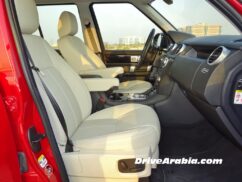First drive: 2015 Land Rover LR4 Black Pack in the UAE

It’s interesting to note that the Land Rover LR4 has been around pretty much unchanged for the past decade. Introduced in 2005 as the LR3, and known as the Discovery elsewhere, the big 4×4 has so far undergone at least two facelifts, reshuffled engine choices, and that aforementioned name-change. The latest model is still fundamentally similar to its predecessors, but it now packs a single engine offering borrowed from sister-company Jaguar.
The engine we’re talking about is a 3.0-litre supercharged V6, mated to an 8-speed automatic and all-wheel-drive. The version we’re driving is the Black Pack.

The Black Pack is nothing more than black wheels and black exterior trim bits. Inside, nothing much has changed over the years since the time we drove the 2010 Land Rover LR4 five years ago.
It still has the same seating arrangement with two spacious rows and a cramped third row, with generous use of soft-touch materials that mimic older Range Rover models. An obvious new addition includes a rotary-dial gear selector, but that’s about it.

Getting back to that new engine, the supercharged V6 making 340 hp and 450 Nm of torque is less powerful than the 5.0-litre V8 it replaced, which used to make 375 hp and 508 Nm. As a result, the new model is 0.2 seconds slower to 100 kph at 8.1 seconds, according to the manufacturer, but a fair bit more fuel-efficient.
The force-fed engine actually does offer more useful power, with a decent kick at low revs that gets you going a bit quicker than the V8 in city driving. However, you do lose the V8 exhaust grunt, as it now sounds like a vacuum cleaner most of the time. Maybe Land Rover should borrow Jaguar’s exhaust system as well. The low-speed throttle response is also uneven, not always on the ball when you push the ‘go’ pedal.

As for the drive, it’s best if you don’t hustle it and just enjoy the smooth air-suspended ride at moderate speeds. The brakes are good enough to back up the decent acceleration, while there’s good grip from the tyres, even if the handling feels lumpy. The steering offers little feedback, but is weighted somewhat firmly, which is at odds with this easy-riding cruiser’s demeanour.
We didn’t take the LR4 offroad because Land Rover made us sign a contract that overtly discourages potentially-damaging activities with their press cars, but we can assure you that the body-on-frame LR4 has all the right equipment to tackle the desert, from height-adjustable air suspension to a driver-selectable terrain-response system, let alone the low-range gearing and hill-descent control. In fact, we suspect the new engine might actually do better than the older V8, with stronger low-end torque to get moving on the soft stuff.
The Land Rover LR4 is starting to show its age, but truth be told, we’ve come to appreciate it more than ever before. The big 4×4 is the last of the boxy Land Rovers and it feels a lot like a previous-generation Range Rover Vogue from behind the wheel. The LR4’s price has crept up over the years, but it may be worth a look if you are keen on an old-school Range Rover-like experience on a more palatable budget.
For prices and specs, visit the Land Rover buyer guide.










Comments
Binoy
Thank you Mash for the update! I guess now people would be also asking for the mileage figures in UAE, which should be the right thing as well, I feel. I guess that also means that diesel vehicles might see a spurt in their demand, as now the price of diesel would be lowered and this would mean better fuel economy too! It is an interesting move and I believe beneficial to the economy, especially in the long term.
A
It’s not exactly BOF, it’s an Integrated Body Frame. The engine bay and passenger compartment are built as a monocoque, then mated to a basic ladder-frame chassis for the gearbox and suspension. Land Rover claims IBF combines the virtues of monocoque and ladder-frame – though it makes for a heavy vehicle, compromising performance and agility.